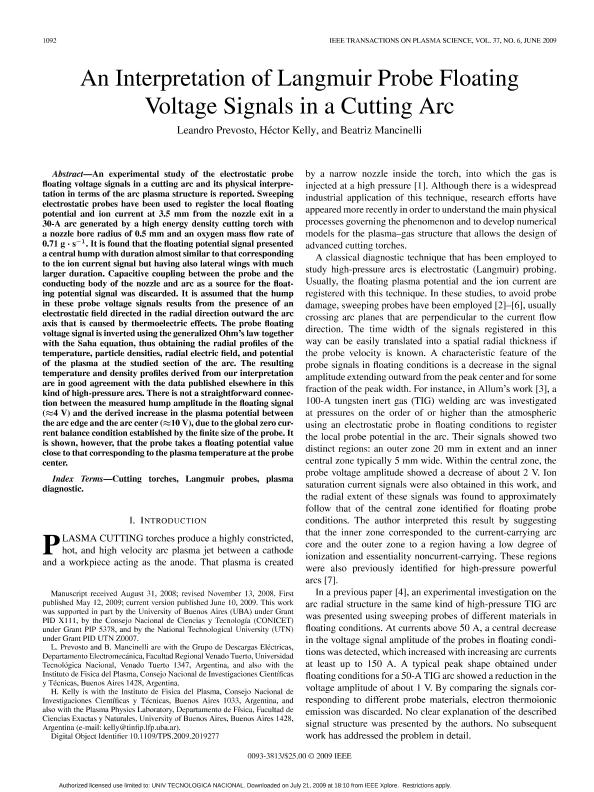Mostrar el registro sencillo del ítem
dc.contributor.author
Prevosto, Leandro

dc.contributor.author
Kelly, Hector Juan

dc.contributor.author
Mancinelli, Beatriz Rosa

dc.date.available
2018-10-02T14:40:06Z
dc.date.issued
2009-12
dc.identifier.citation
Prevosto, Leandro; Kelly, Hector Juan; Mancinelli, Beatriz Rosa; An interpretation of langmuir probe floating voltage signals in a cutting arc; Institute of Electrical and Electronics Engineers; IEEE Transactions on Plasma Science; 37; 6 PART 2; 12-2009; 1092-1098
dc.identifier.issn
0093-3813
dc.identifier.uri
http://hdl.handle.net/11336/61479
dc.description.abstract
An experimental study of the electrostatic probe floating voltage signals in a cutting arc and its physical interpretation in terms of the arc plasma structure is reported. Sweeping electrostatic probes have been used to register the local floating potential and ion current at 3.5 mm from the nozzle exit in a 30-A arc generated by a high energy density cutting torch with a nozzle bore radius of 0.5 mm and an oxygen mass flow rate of 0.71 g · s-1. It is found that the floating potential signal presented a central hump with duration almost similar to that corresponding to the ion current signal but having also lateral wings with much larger duration. Capacitive coupling between the probe and the conducting body of the nozzle and arc as a source for the floating potential signal was discarded. It is assumed that the hump in these probe voltage signals results from the presence of an electrostatic field directed in the radial direction outward the arc axis that is caused by thermoelectric effects. The probe floating voltage signal is inverted using the generalized Ohm's law together with the Saha equation, thus obtaining the radial profiles of the temperature, particle densities, radial electric field, and potential of the plasma at the studied section of the arc. The resulting temperature and density profiles derived from our interpretation are in good agreement with the data published elsewhere in this kind of high-pressure arcs. There is not a straightforward connection between the measured hump amplitude in the floating signal (≈4 V) and the derived increase in the plasma potential between the arc edge and the arc center (≈10 V), due to the global zero current balance condition established by the finite size of the probe. It is shown, however, that the probe takes a floating potential value close to that corresponding to the plasma temperature at the probe center. © 2009 IEEE.
dc.format
application/pdf
dc.language.iso
eng
dc.publisher
Institute of Electrical and Electronics Engineers

dc.rights
info:eu-repo/semantics/openAccess
dc.rights.uri
https://creativecommons.org/licenses/by-nc-sa/2.5/ar/
dc.subject
Cutting Torches
dc.subject
Langmuir Probes
dc.subject
Plasma Diagnostic
dc.subject.classification
Astronomía

dc.subject.classification
Ciencias Físicas

dc.subject.classification
CIENCIAS NATURALES Y EXACTAS

dc.title
An interpretation of langmuir probe floating voltage signals in a cutting arc
dc.type
info:eu-repo/semantics/article
dc.type
info:ar-repo/semantics/artículo
dc.type
info:eu-repo/semantics/publishedVersion
dc.date.updated
2018-10-01T15:54:45Z
dc.journal.volume
37
dc.journal.number
6 PART 2
dc.journal.pagination
1092-1098
dc.journal.pais
Estados Unidos

dc.journal.ciudad
Washington
dc.description.fil
Fil: Prevosto, Leandro. Universidad Tecnológica Nacional. Facultad Regional Venado Tuerto; Argentina. Consejo Nacional de Investigaciones Científicas y Técnicas; Argentina. Consejo Nacional de Investigaciones Científicas y Técnicas. Oficina de Coordinación Administrativa Ciudad Universitaria. Instituto de Física del Plasma. Universidad de Buenos Aires. Facultad de Ciencias Exactas y Naturales. Instituto de Física del Plasma; Argentina
dc.description.fil
Fil: Kelly, Hector Juan. Universidad de Buenos Aires. Facultad de Ciencias Exactas y Naturales; Argentina. Consejo Nacional de Investigaciones Científicas y Técnicas; Argentina. Consejo Nacional de Investigaciones Científicas y Técnicas. Oficina de Coordinación Administrativa Ciudad Universitaria. Instituto de Física del Plasma. Universidad de Buenos Aires. Facultad de Ciencias Exactas y Naturales. Instituto de Física del Plasma; Argentina
dc.description.fil
Fil: Mancinelli, Beatriz Rosa. Universidad Tecnológica Nacional. Facultad Regional Venado Tuerto; Argentina
dc.journal.title
IEEE Transactions on Plasma Science

dc.relation.alternativeid
info:eu-repo/semantics/altIdentifier/doi/http://dx.doi.org/10.1109/TPS.2009.2019277
Archivos asociados
